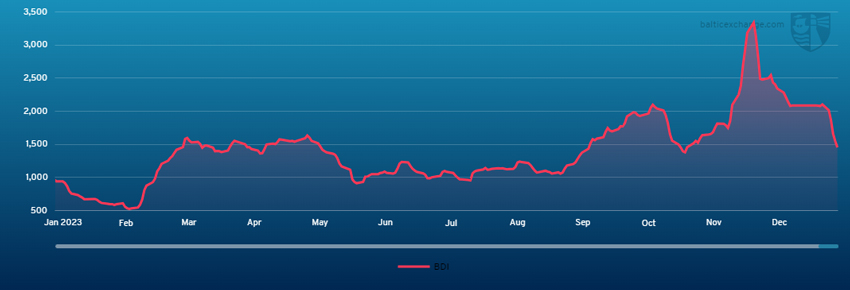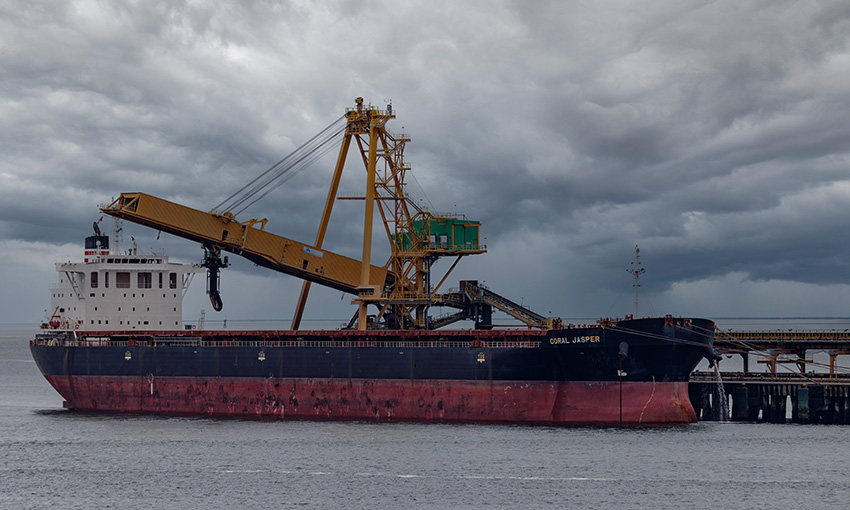THE BALTIC Dry Index fell over the past week to 1460 on Friday 12 January – a decrease of 30% on the previous Friday’s index.
This past Friday marked the lowest point for the index since early November 2023, and it is a decrease of 43% on the recent peak of 2551 on 12 December.

Capesize
The Capesize market concluded the week on a relatively sombre note.
The Pacific market struggled with limited participation from the miners throughout the week, resulting in declining rates driven by tonnage build-up and an overall shortage of coal enquiry.
The Atlantic market faced a slow start, with notable bid reductions from charterers, leading to a widening bid-offer spread and fewer fixtures being concluded. However, towards the end of the week, there were indications of increased activity from South Brazil and West Africa to the Far East, suggesting a potential attempt to find a market equilibrium. By midweek, the North Atlantic market exhibited signs of stabilisation after experiencing substantial downturns earlier in the week. This resulted in market conditions remaining somewhat subdued as the week drew to a close, reflecting the impact of growing tonnage against a backdrop of diminishing cargo availability.
The BCI 5TC commenced the week at US$29,851 but experienced notable losses, concluding the week at US$18,015 by Friday’s close.
Panamax
The decline in the Panamax market showed no signs of abating this week, with further substantial corrections in both basins.
In the Atlantic, a distinct lack of mineral demand in the North, as well as a build-up of tonnage count, weighed heavily on the very few deals to be reported this week. Limited talk midweek of a floor being found from EC South America appeared premature, with charterers still able to pick off the ample ballasters, dependent on the arrival window, the customary rate variance played out but generally the P6 route averaged out to around US$13,500 and US$13,750 levels.
Asia also remained downcast, with Indonesian coal exports continuing to be an issue and, despite some minor support ex NoPac and Australia, this did little to impact an ever-growing tonnage count with limited options. Mixed rates on period throughout the week, the highlight being an 82,000-dwt delivery China achieving US$14,350 for one year.
Ultramax/Supramax
The rather inauspicious start to the new year continued over the week with little for owners to get excited about.
In the Atlantic, activity appeared softer in most key areas with a healthy tonnage supply more than keeping up with demand. Brokers spoke of very little requirement from the South Atlantic for trans-Atlantic runs.
From the Asian arena, some described the week as positional. With a reasonable number of fresh requirements both from the NoPac and Australia, limited fresh enquiry further south saw rates remain in check for the most part.
Activity from the Atlantic included a 63,000-dwt fixing a trip delivery EC North America redelivery East Mediterranean at US$24,000. Elsewhere, a 58,000-dwt was fixed delivery North Continent for a scrap run to East Mediterranean in the mid US$16,000s.
From Asia, a 63,000-dwt open North China for heard fixed for a NoPac round voyage redelivery WC India at US$12,750. From the south, a 55,000-dwt open South China was fixed for a trip via Vietnam redelivery Bangladesh at US$9,000.
Handysize
Continued negativity was seen across the handy sector, with limited cargo availability and growing tonnage lists continuing. In the Mediterranean, a 28,000-dwt was fixed from Arzew to Florida with bagged cement at US$7,500 whilst a 40,000-dwt was rumoured to have fixed for from Algeria to US Gulf at US$9,000.
The South Atlantic also saw levels fall, with a 36,000-dwt fixing from Santos to Morocco with a cargo of sugar in the mid-teens whilst a 36,000-dwt was said to have been fixed from Rio Grande to WC Central America at US$23,000. With similar market conditions in the US Gulf, sentiment remained negative.
Southeast Asia also experienced a lack of fresh enquiry as a 38,000-dwt fixed from Singapore via Western Australia to China with alumina at US$8,400. Further north, a 34,000-dwt opening in CJK fixed a trip to Southeast Asia at US$8,000. Period interest was still evident with a 28,000-dwt in Cigading fixing for four-to-six months at US$9,250.
Clean
LR2
LRs in the MEG continued their downward track this week. The 75Kt MEG/Japan TC1 index dropped another 15.78 points to WS153.61. The 90kt MEG/UK-Continent TC20 run to the UK-Continent also came down US$393,000 to US$4.525 million.
West of Suez, Mediterranean/East LR2s on TC15 recorrected back down this week seen in the index shedding US$100,000 to US$4.433 million.
LR1
In the MEG, LR1s have managed to be resolute this week despite their larger siblings losing value. The 55kt MEG/Japan index of TC5 is currently marked at WS188.44 and has hovered around the mid WS180s all week. Meanwhile, 65kt MEG/UK-Continent on TC8 dropped to the tune of US$157,000 to US$3.9 million.
On the UK-Continent, the 60Kt ARA/West Africa TC16 index, also began to soften this week and is currently pegged at WS192.06 (-8.69).
MR
MRs in the MEG have resurged this week off the back of plenty of activity on the size, with the TC17 index hopping up 41 points of 17% to WS277.86.
UK-Continent MRs, after being tested down hard last week, looked to have reached a floor. The 37kt ARA/US-Atlantic coast of TC2 floated around WS117-119 all week with activity being enough to keep players interested and vessels being fixed at varying freight levels, dependent on amongst other factors, voyage requirements. On a TC19 run (37kt ARA/West Africa) the index climbed after a couple of fixtures during the week shedding light on the market status, the index climbed 10.06 points to WS141.25.
The USG MRs began to show some resolve this week. Freight has as a result began to resurge in the region. TC14 (38kt US-Gulf/UK-Continent) went from WS153.21 to WS170. The 38kt US Gulf/Brazil on TC18 was more stable moving up from WS217 to WS220. The 38kt US-Gulf/Caribbean TC21 hopped back up over the US$700,000 mark to US$714,286 keeping the Baltic round trip TCE for the run over US$20,000/day.
The MR Atlantic Triangulation Basket TCE went from US$21,790 to US$24,581.
Handymax
In the Mediterranean, Handymaxes continued their current downward movement, seeing the TC6 index drop from WS199.17 to WS192.28.
Up in northwest Europe, the TC23 30kt Cross UK-Continent again was firmly affected by downward pressure and the index lost 30.56 points to WS152.83.
VLCC
The market has taken a turn upwards this week, with the 270,000 mt Middle East Gulf to China route rising nine points to WS68.50, which translates into a daily round-trip TCE of US$42,134 basis the Baltic Exchange’s vessel description.
In the Atlantic market a similar situation has been seen with the rate for 260,000 mt West Africa/China climbing 11 points to WS73.95 (which shows a round voyage TCE of US$49,194/day) while the rate for 270,000 mt US Gulf/China steadied before rising, with each new fixture higher than the previous one. Ultimately over the week it gained US$1,733,333 to US$10,244,444, which provides a round-trip daily TCE of US$28,598.
Suezmax
Suezmaxes in West Africa have been flat this week with the rate for 130,000 mt Nigeria/UK Continent route remaining at the WS142-143 mark (a daily round-trip TCE of US$57,893). In the Mediterranean and Black Sea region, the rate for 135,000 mt CPC/Med route has modestly risen two points to WS145.55 (showing a daily TCE of US$64,545 round-trip). In the Middle East, the rate for 140,000 mt Middle East Gulf to the Mediterranean lost a further 3.5 points this week to WS87.56 on the back of a continued quiet local market.
Aframax
In the North Sea, the rate for the 80,000 mt Cross-UK Continent route is marginally firmer, up a solitary point, to WS182.5 (showing a round-trip daily TCE of US$72,097 basis Hound Point to Wilhelmshaven).
In the Mediterranean market the rate for 80,000 mt Cross-Mediterranean has improved by 18 points to WS184.33 (basis Ceyhan to Lavera, showing a daily round trip TCE of US$55,939).
On the other side of the Atlantic, the market has continued to strengthen. The rate for 70,000 mt East Coast Mexico/US Gulf (TD26) has rocketed another 60 points this week to WS345.94 (a daily round-trip TCE of US$118,134) and the 70,000 mt Covenas/US Gulf rate is 50 points firmer at WS324.38 (a round-trip TCE of US$96,727/day). The rate for the trans-Atlantic route of 70,000 mt US Gulf/UK Continent has increased by another 22 points to WS302.5 (a round trip TCE basis Houston/Rotterdam of US$83,898/day).
LNG
Despite a fixture in the east reported at US$50,000/day on the TFDE ships and US$75,000/day on the 2-Strokes, the index fell again on the back of a lack of general activity. As we have seen happen in the past at this time of year, the constructs of the deals have morphed and rather than any round trip basis we have seen a couple of fixtures concluded with ballast to hub only. A few new ships opening up in the Atlantic has put pressure on rates as well, and though we are in winter season with a few particularly cold snaps across Europe, gas storage has remained high, so shipping demand hasn’t been great.
Rates have fallen for the 10th week in a row, with periods of stabilisation here and there. However, there is little to support a rise in rates currently and the market outlook hasn’t been too optimistic from brokers. On the TFDE BLNG1g Australia-Tokyo a fall of US$16,670 gave a final publication of US$47,551 (despite reports of one TFDE ship fixed at US$50,000 PD). BLNG2g Houston-Cont dropped down to US$63,380 while BLNG3g Houston-Tokyo fell to US$66,323.
On the 2-strokes a fixture at US$75,000/day on Aus-Japan couldn’t stave off a fall and we published at US$69,241, while Houston-Cont fell to US$85,018 and BLNG3-174 Houston-Tokyo dropped the most at US$28,094 to close at US$87,906.
Period has remained flat, with little reported done on short or longer term at the moment and rates have remained steady with six-months on 174cbm 2-Stroke US$67,500, one-year at US$90,767, while the three-year fell to US$95,800.
LPG
What a week for the LPG market, one that will go down (and this is meant both literally and figuratively) as one to try and forget. A huge fall on all three routes this week, with product woes, a longer tonnage list, and an arb that is working against the market all contributed to a big decrease across the board. BLPG1 Ras Tanura-Chiba fell by US$38.714 making it one of the biggest weeks falls for the last few years. A close price below US$100 from mid-US$130’s was not what the market wanted to see and with a final publication of US$98.143 and a daily TCE earning equivalent of US$83,487 with little view of the bottom so far has many brokers reaching for an early weekend.
It was an even more troublesome week for the market in the Atlantic. The biggest weeks fall on BLPG3 seen at US$58.572 saw two consecutive days of about US$20 shaved off the index. While perhaps BLPG Houston-Flushing saw the best of the worst this week, losing only US$21.8, it has done so only on the fact very little if any cargoes were reported fixed that way. BLPG3 Houston-Chiba shrunk by 26.83% to close out at US$159.714 and a daily TCE earning equivalent of US$85,993. Regardless, few fixtures and an arb working against the market doesn’t bode well for the beginning of next week either.

